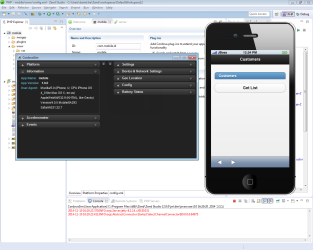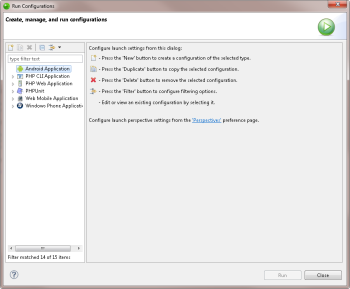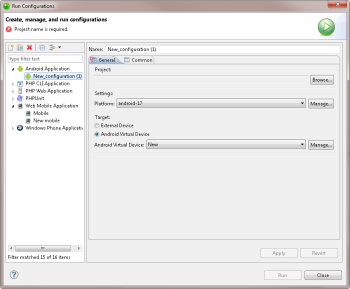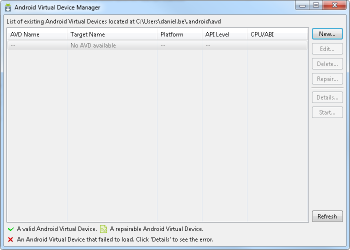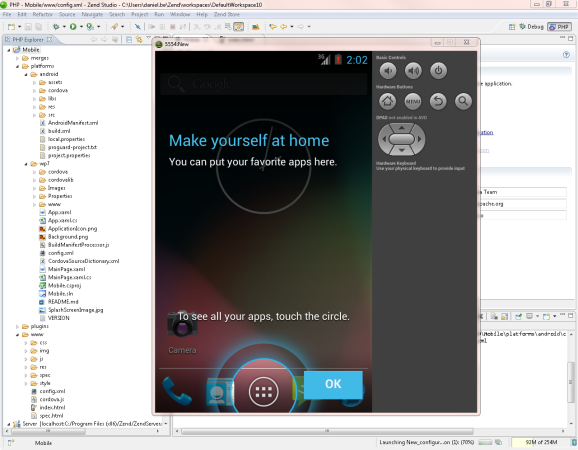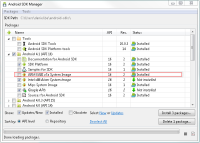Running Mobile Projects
Important:
Testing or running your native application from within Zend Studio requires existing conditions depending on the native platform being tested. Please take note of the relevant 'Prerequisites' sections on this page: Android, iOS, Windows Phone.
This procedure explains how to test a CCM client-side project by running your Web Mobile application using the CordovaSim emulator. The CordovaSim emulator is a light-weight mobile application simulator that allows you to preview your mobile application during and after development.
CordovaSim loads faster, runs faster and consumes less memory, and is ideal for quickly testing small changes during the development cycle. It also provides a control panel for easily simulating events through the Cordova API.
|
|
|
|
|
To test on the CordovaSim emulator:
|
|
To configure launch settings, right-click the project in the PHP Explorer, and select Run As | Run Configurations. |
|
Using the Android mobile device emulator or on an actual device, you can test your mobile project as a native mobile application.
Prerequisites
- Existing Mobile project. See Creating a New Hybrid Mobile Project or Creating a New Cloud Connected Mobile Project for more information.
- Installed Android SDK:
- Go to http://developer.android.com/sdk/index.html#download
- Click Use an Existing IDE. (On Ubuntu 13.10 only - scroll down to SDK Tools Only, and download Linux package).
- Click the Download button.
- Once installed, open the SDK Manager and install Android 4.2.2 (API 17) and Android 4.3 (API 18).
Note:
Using ADT on Linux 64-bit requires installation of ia32-libs. To do this, run:
sudo apt-get update
sudo apt-get install ia32-libs
For Fedora 64-bit (RPM), install redhat-lsb.i686. To do this, run:
sudo yum install redhat-lsb.i686
Running Applications On the Android Emulator
The Android SDK includes a mobile device emulator - a virtual mobile device that runs on your computer. The emulator lets you develop and test Android applications without using a physical device. Click here for more information on the Android Emulator.
|
|
|
|
|
To run an Android application on the Android Emulator:
|
|
If your application fails to run on the emulator, check if the ARM System Image is installed on your Android SDK: Open the Android SDK Manager and view installed packages. Install the package if it not installed, and repeat the procedure above. |
|
Running Applications On a Device
This option allows you to run your Android native application on an actual device from within Zend Studio.
|
|
|
|
|
To run your Android application on an actual device:
|
To configure the Android launch device and emulator settings, right-click the project in the PHP Explorer, and select Run As | Run Configurations.
Using the iOS Simulator or on an actual device using Xcode, you can run your mobile project as a native iOS application.
Note:
Only available for Mac OS X.
Prerequisites
- Existing Mobile project. See Creating a New Hybrid Mobile Project or Creating a New Cloud Connected Mobile Project for more information.
- Installed Xcode. Click here to download and install.
- To test on an actual device:
Registered iOS developer. Click here to register.
Running Applications On the iOS Simulator
The iOS Simulator presents the iPhone or iPad user interface in a window on your computer. The simulator provides several ways to interact with it by using the keyboard and mouse to simulate taps, device rotation, and other user actions. Click here for more information on the iOS Simulator.
|
|
|
|
|
To run an iOS application using the iOS Simulator: In the PHP Explorer, right-click your native project, and select Run As | Run on iOS Emulator. |
|
To configure launch settings, right-click the project in the PHP Explorer, and select Run As | Run Configurations. You can configure the project to be launched, the SDK to be used in the iOS simulator, and the device family (iPhone, iPad). |
|
Running Applications On a Device
This option allows you to run your iOS native application on an actual device from within Zend Studio.
|
|
|
|
|
To run an iOS application on an actual device:
|
|
|
|
Using the Windows Phone emulator, MS Visual Studio, or an actual device, you can run your mobile project as a native Windows Phone application.
Prerequisites
- Existing Mobile project. See Creating a New Hybrid Mobile Project or Creating a New Cloud Connected Mobile Project for more information.
- Installed Windows Phone SDK. Click here to download and install.
- To test on an actual device:
Running Applications On the Windows Phone Emulator
The Windows Phone emulator emulates a Windows Phone 8 or a Windows Phone 8.1 device. It provides a virtualized environment in which you can develop, debug, and test Windows Phone applications. It also provides an isolated environment for early application prototypes. By using the emulator, you can proceed through the common application development scenarios without a physical device. This can reduce the cost of developing applications for Windows Phone.
|
|
|
|
|
To run a Windows Phone application using the Windows Phone emulator: In the PHP Explorer, right-click your mobile project, and select Run As | Run on Tip: If you have modified your project and want to test your updates simply re-select Run as | Windows Phone 8 Application, and the updated application will be deployed to your running emulator. There is no need to close and re-launch the emulator. |
|
Your Windows Phone application can also be run in the Microsoft Visual Studio. To do this, right-click the application in the PHP Explorer, and select Open in Visual Studio. |
|
Running Applications On a Device
This option allows you to run your Windows Mobile native application on an actual device from within Zend Studio (MS Visual Studio does not need to be opened).
Important:
See Prerequisites above.
|
|
|
|
|
To run a Windows Mobile application on an actual device:
|
|
|
|

